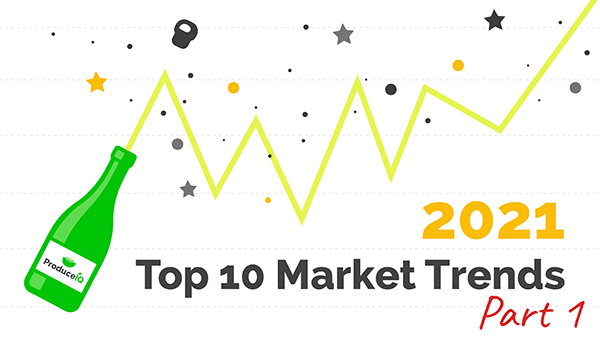ProduceIQ is bringing a bonus gift in addition to its weekly market highlights: a look to 2021, analyzing the “new normal” of 2020, and the challenges/opportunities expected to persist in in the coming months.
In today’s segment, we’ll break down five of the Top 10 trends driving the produce market:
10 – Higher Freight rates
Produce sales and refrigerated freight are inseparable. The availability of reefer trucks for fresh produce is being constrained by increased compliance with stricter logbook rules, California truck emission laws, and driver shortages. Given increased demand from other supply chains (e.g. Amazon effect) for this limited supply of equipment and drivers, anticipate continued high freight rates.
9 – Consolidating suppliers
Despite the desire for small and local farmers, the supply side is continuing to consolidate. Large grower-shippers are getting larger as the fixed costs of production increase with the value of year-round customer continuity. Likewise, on the buy side, major retailers and foodservice distributers gain market share and increase in size. As production becomes less fragmented, planting schedules will be driven by known customer demand, programs will become more important and the spot market will move less volume. Produce prices should outpace core inflation as the supply side becomes more disciplined.
8 – Programs, spot markets, and Acts of God
This year’s volatility tested our produce supply chain. Increasing levels of participants are seeking programs, contracts, and an ability to reduce market risk. However, these programs need to have increased flexibility to accommodate the unforeseen. The government shutdown of restaurants in March created another new reason that contracts need an Act of God clause and plan B flexibility. Unlike spot markets for non-perishables, the produce industry witnessed the inability of suppliers to quickly connect with new customers, causing millions of dollars of produce to be wasted. Improving resiliency is the new buzzword for our produce markets.
7 – Extreme weather & CEA
It may be an oxymoron to say, but natural phenomena are quite commonplace for the produce industry. In 2020 the industry battled California forest fires, extreme temperatures, an abnormally wet summer and hurricanes in November. The business model for controlled-environment agriculture or CEA in certain commodities has been proven. This sector recently raised significant amounts of capital for new greenhouse and high-tech indoor facilities.
6 – Digital transformation
Though known for being a highly personal and low-tech industry, fresh produce was required to adapt to working from home (WFH), limited travel, virtual tradeshows, zoom meetings, and online ordering. In 2016, McKinsey Global Institute rated agriculture as the least digitized of all 22 industries studied. However, Covid-19 has acted as a catalyst for an industry previously deemed technologically undeveloped.
Watch for the Top 5 in tomorrow’s post.
Blue Book has teamed with ProduceIQ BB #:368175 to bring the ProduceIQ Index to its readers. The index, and weekly analysis, provides a produce industry price benchmark using 40 top commodities to provide data for decision making.



